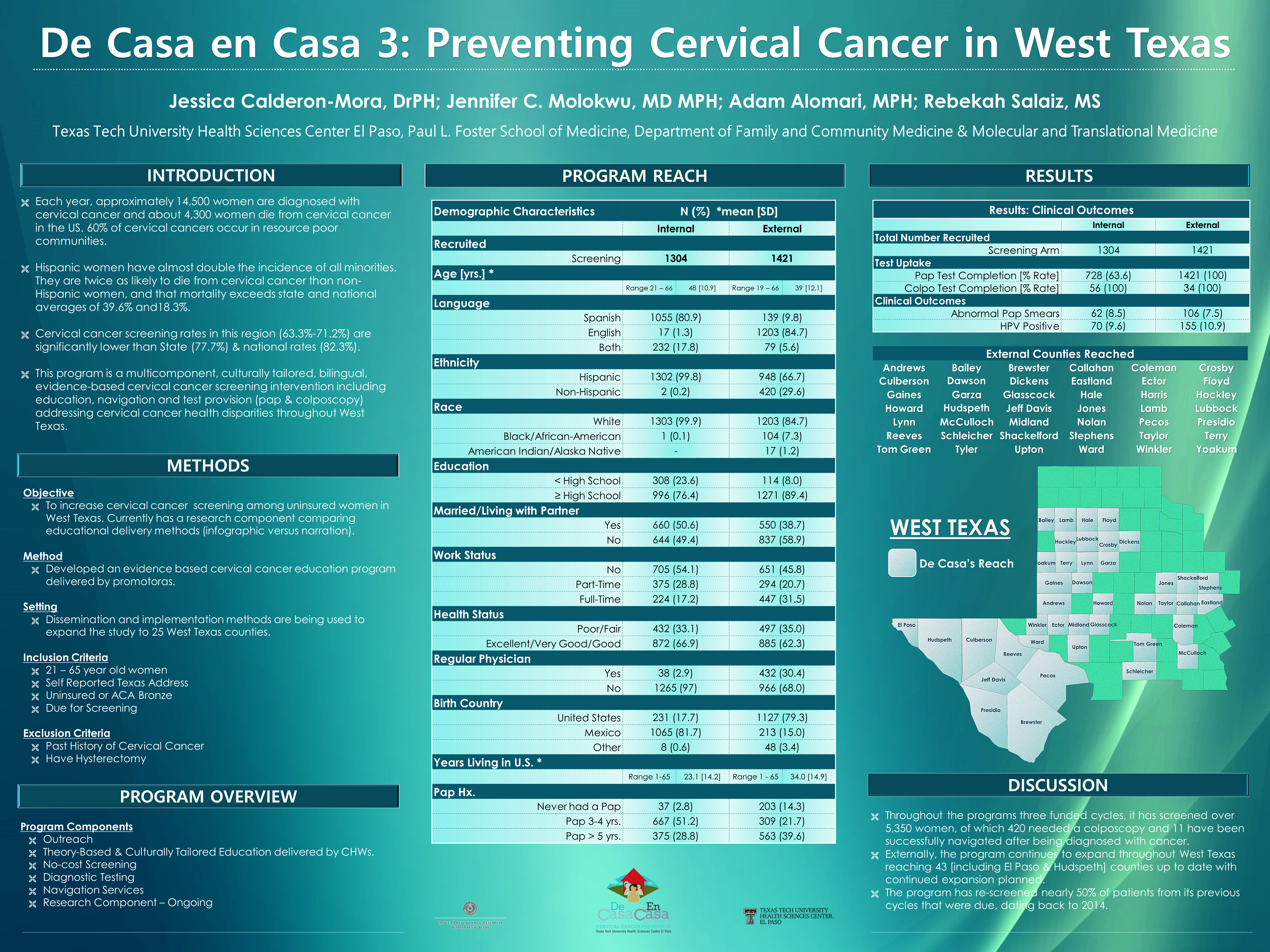PRP022: De Casa En Casa 3: Preventing Cervical Cancer in West and South Texas
Jessica Calderon-Mora, DrPH, DrPH; Adam Alomari; Jennifer Molokwu, MD, FAAFP, MPH; Rebekah Salaiz
Abstract
Context: Women living in undeserved rural/border communities in West and South Texas have critical barriers to cervical cancer screening, specifically uninsured and rural populations. Hispanic women and women in rural areas have higher incidence, are diagnosed at later stages and suffer disproportionate mortality compared to non-Hispanic white women or women in urban areas.
Objective: To increase cervical cancer screening in underserved areas by addressing the needs of the community and gaps in services.
Study Design: Descriptive study.
Setting: Areas in West and South Texas, targeting 16 screening sites within a 58 county area.
Population Studied: Women, 21-65 years old.
Intervention: De Casa 3 builds upon and expands a multicomponent evidence-based, culturally tailored, bilingual and theory based program. Key program components include: 1) theory-based and culturally tailored cervical cancer education; 2) provision of no-cost pap and HPV screening; 3) on-site diagnostic/treatment colposcopy; 4) patient navigation/tracking to facilitate screening, diagnosis, health insurance coverage, access to a PCP and treatment; 5) enhanced resident/faculty colposcopy training to increase capacity.
Outcome Measure: Cervical cancer screening.
Results: Within El Paso County 900 women have entered the program; all were educated and were screening eligible: mean age 47.5 years. 29.3% (n=977) had never had a pap smear or last received a pap in over 5 years. Screening uptake is 61% (n=415); 7.7% (n=32) required a colposcopy, with a 100% completion rate. 8.7% (n=36) were positive for high risk HPV and 1 cancer has been diagnosed. The program has reached 36 West and South Texas counties; providing screening services to 1,225 women, 33 (2.7%) completed a colposcopy. Additionally, we are conducting an education evaluation throughout West Texas, evaluating the effectiveness of two short informational videos, one with infographics/narration versus only narration by a community health worker; 500 will be enrolled, 44 have completed the study up to date.
Expected Outcomes: This program can have a major impact on cervical cancer prevention, expanding on an effective program to individuals in over 20% of all Texas counties, helping meet the goals of the Texas Cancer Plan to reduce the impact of cancer through viable and effective programs that target the underserved and reduce cancer disparities.
Objective: To increase cervical cancer screening in underserved areas by addressing the needs of the community and gaps in services.
Study Design: Descriptive study.
Setting: Areas in West and South Texas, targeting 16 screening sites within a 58 county area.
Population Studied: Women, 21-65 years old.
Intervention: De Casa 3 builds upon and expands a multicomponent evidence-based, culturally tailored, bilingual and theory based program. Key program components include: 1) theory-based and culturally tailored cervical cancer education; 2) provision of no-cost pap and HPV screening; 3) on-site diagnostic/treatment colposcopy; 4) patient navigation/tracking to facilitate screening, diagnosis, health insurance coverage, access to a PCP and treatment; 5) enhanced resident/faculty colposcopy training to increase capacity.
Outcome Measure: Cervical cancer screening.
Results: Within El Paso County 900 women have entered the program; all were educated and were screening eligible: mean age 47.5 years. 29.3% (n=977) had never had a pap smear or last received a pap in over 5 years. Screening uptake is 61% (n=415); 7.7% (n=32) required a colposcopy, with a 100% completion rate. 8.7% (n=36) were positive for high risk HPV and 1 cancer has been diagnosed. The program has reached 36 West and South Texas counties; providing screening services to 1,225 women, 33 (2.7%) completed a colposcopy. Additionally, we are conducting an education evaluation throughout West Texas, evaluating the effectiveness of two short informational videos, one with infographics/narration versus only narration by a community health worker; 500 will be enrolled, 44 have completed the study up to date.
Expected Outcomes: This program can have a major impact on cervical cancer prevention, expanding on an effective program to individuals in over 20% of all Texas counties, helping meet the goals of the Texas Cancer Plan to reduce the impact of cancer through viable and effective programs that target the underserved and reduce cancer disparities.

Jack Westfall
jwestfall@aafp.org 11/21/2021This is a great topic and research study. Nice work. Thanks